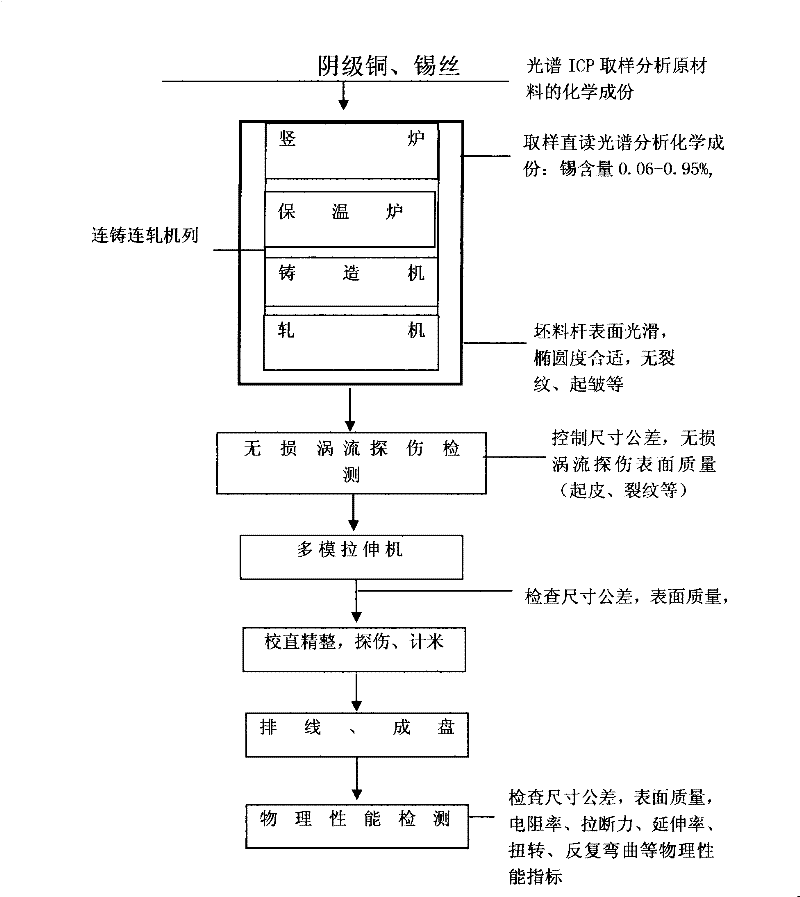Low tin-copper alloy contact wire for electric railway and manufacturing method thereof
A technology for electrifying railways and tin-copper alloys, which is used in cable/conductor manufacturing, electrical components, metal/alloy conductors, etc., to achieve the effects of low production cost, good machinability and high softening temperature
- Summary
- Abstract
- Description
- Claims
- Application Information
AI Technical Summary
Problems solved by technology
Method used
Image
Examples
Embodiment 1
[0029] Low-tin-copper alloy contact wire for electrified railways and its manufacturing method:
[0030] A low-tin-copper alloy contact wire billet rod with a diameter of φ28mm is produced by continuous casting and rolling process. Wherein the tin is added to the upper part of the downflow tank with a quantitative adding device with a diameter of φ6mm. Finally, after hot rolling, the section will be 2300mm 2 The cast bar is hot-rolled into a Φ28mm billet rod, and its hot-processing passes can be 4 to 8 times, and the pass processing rate is 18.5-23.5% per pass, the total hot-working rate is 73.26%, and the hot-rolling temperature is 750-830 ℃, the grain size is 0.015-0.018mm, hot rolling is enough to change the as-cast grain size of the alloy metal, but it lays a good foundation for the subsequent cold working rate to improve the performance index.
[0031] Put high-purity cathode copper into the vertical melting furnace, the fuel is natural gas, control the temperature of t...
Embodiment 2
[0035] Add 35 tons of high-purity cathode copper to the vertical melting furnace. When the temperature of the holding furnace rises to 1140°C to 1150°C, the atmosphere in the furnace is guaranteed to be slightly reduced, and production begins. The molten liquid metal flows into the ladle continuously through the lower chute, and metal tin wire is added in the lower chute at a weight percentage of 0.097% by wire feeding method, and the amount added is synchronized with the casting speed. Sampling and analysis showed that casting and rolling started after the tin content was qualified. The temperature of the ladle was controlled at 1100-1120°C, the casting speed was 750rpm, and the cooling water pressure was 0.08-0.25Mpa. After cooling and solidification, the billet was formed. The casting cross-section was trapezoidal. Cross-sectional area 2300mm 2 . The casting slab is sent into a rolling mill with a running speed of 750rpm for four consecutive rolling passes, and the rolling...
Embodiment 3
[0037] A low-tin-copper alloy contact wire billet rod with a diameter of φ28mm is produced by continuous casting and rolling process. Wherein the tin is added to the upper part of the downflow tank with a quantitative adding device with a diameter of φ6mm. Finally, after hot rolling, the section will be 2300mm 2 The hot-rolled cast bar is Φ28mm billet rod, the number of hot-working passes is 4-8 times, the processing rate of each pass is 18.5-23.5%, the total hot-working rate is 73.26%, and the hot-rolling temperature is 750-830°C. The grain size is 0.015 ~ 0.018mm. Hot rolling is enough to change the as-cast grain size of the alloy metal, but it lays a good foundation for the subsequent cold working rate to improve the performance index.
PUM
| Property | Measurement | Unit |
|---|---|---|
| area | aaaaa | aaaaa |
| area | aaaaa | aaaaa |
| diameter | aaaaa | aaaaa |
Abstract
Description
Claims
Application Information
 Login to View More
Login to View More - R&D
- Intellectual Property
- Life Sciences
- Materials
- Tech Scout
- Unparalleled Data Quality
- Higher Quality Content
- 60% Fewer Hallucinations
Browse by: Latest US Patents, China's latest patents, Technical Efficacy Thesaurus, Application Domain, Technology Topic, Popular Technical Reports.
© 2025 PatSnap. All rights reserved.Legal|Privacy policy|Modern Slavery Act Transparency Statement|Sitemap|About US| Contact US: help@patsnap.com

